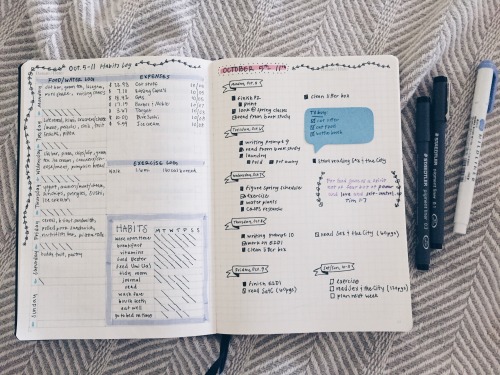The Thesis Progress Journal
the thesis progress journal
it’s all based on louise desalvo’s concept of a process journal for writers, from her book ‘the art of slow writing’ which i read way back in 2014 but has stayed with me all this time. she based that concept on sue grafton’s journal, which “stands as a record of the conversation she has with herself about the work in progress.” desalvo talks about her own process journal : “to plan a project, list books i want to read, list subjects i want to write about, capture insight about my work in progress, discuss my relationship to my work (what’s working and what’s not, whether i need to make changes to my writing schedule, how i’m feeling about the work)”
her view of the concept is so interesting and can easily be applied to grad school : “keeping a process journal helps us understand that our writing is important work. we value it enough to plan, reflect, and evaluate our work. a process journal is an invaluable record of our work patterns, our feelings about our work, our responses to ourselves as writers, and our strategies for dealing with difficulties and challenges.”
she says, and i quote : “our progress journals are where we engage in the nonjudgmental, reflective witnessing of our work. here, we work at defining ourselves as active, engaged, responsible, patient writers.” and like ???? yes, go off louise!
every week i make an entry with my three to five priorities. since i currently still have seminars, my entire week cannot be dedicated to my thesis, so these priorities allow me to really focus on specific things. they can be bigger or smaller depending on the amount of time i have to work on my thesis.
every day i work on my thesis, i make an entry. i try to answer two questions : “what did i do that day to make progress on my thesis?” as well as “how am i feeling & what i can do to feel better?” i also choose two to five specific tasks to achieve that day and write about the progress. for example, if my task is reading an article, i’ll write it down, check the box once i do it and write a summary of the “experience” (how was the article, was it useful for my research, should i read more of that author’s work, etc.) that way, i can look back at previous tasks, know what happened and learn from it.
i also use the journal almost like a bullet journal (the OG kind) with ongoing lists of important things. of course, there are some to do lists here and there (even though i prefer having my comprehensive task list on todoist), but it’s mostly things like
names of people who have helped me so i can thank them in my thesis
call numbers of books to borrow or archives to consult
research hypotheses
things to look for in the archives i consult
questions to ask my professor/advisor/archivist/etc.
issues that need to be fixed in my thesis
books/articles to read
additional things to research
i also use it as a regular notebooks for all things thesis. one of my seminars this semester is a methodology course, so i take notes in my journal as reference. i also sometimes will write some reading notes if i don’t have my computer on me, such as key quotes or arguments. also, all of my notes from meetings/calls/emails with my advisor are put in the journal, as well as a any pertinent meeting notes (with an archivist, fellow student, my mom, etc.) lastly, sometimes it just becomes a catch all for brainstorm sessions and random thoughts.
for me, this thesis progress journal is the best way to take a step back from the actual work and reflect on what i’m doing, good or bad, and what i can do to make things better, but most importantly, it allows me to understand my progress.
More Posts from Swirlspill-study and Others









Hey guys! These are 7 (technically 8) tips on how to get straight A’s! I’m sorry for the mistakes — ONE: the tip “Some Study Methods” should actually be number 7, not number 1 hehe. TWO: in tip number 6, “Doing your homework”, it says ‘always remember tip number 6!’ what I mean is *always remember tip number 5!* STUDYBLRS — reblog this for a possible follow hehe (see tip 3). Anyway this whole thing took me HOURS. Hopefully it helps someone! ily all & good luck!
Introduction to LaTeX!
No, not the rubbery plasticy stuff
LaTeX (pronounced “lay-tech”) is a free document-formatting system commonly used in STEM fields. This post is going to explain why it is really useful and where you can start!
So if you’re a STEM student, you’ve probably had to write a whole lot of lab reports and know how annoying it is to either figure out Word’s equation editor or screenshot a picture of whatever equation you’re trying to include in your report. Not to mention how awful Word is at formatting pictures, holding them in place and keeping things consistent. LaTeX solves most of those problems for you.
It works with some simple commands and packages that allow you to create journal-style articles, lab reports, and all sorts of other document types. You can include all sorts of mathematical and scientific symbols and equations and LaTeX formats them correctly for you. It might seem daunting at first, but most of the commands are very intuitive and you have a lot of easy customisation and consistent formatting. It can even do referencing for you. It has a lot of other cool things like generating a table of contents, automatically numbering your tables and figures, that contribute to producing a professional-looking scientific document.
All in all, the learning curve is very shallow, and the skill payoff is worth the small time investment it takes to learn. LaTeX typesetting is a very valuable skill to have in STEM.
Where to start:
There are dozens of downloadable LaTeX text editors, but I prefer to use an online one called Overleaf. It has several templates available for you to start from, provides shareable links, renders your document as you work, and, because it’s online, you can upload all your files to the server and work from anywhere.
I found the first chapter of this guice very helpful when I began using LaTeX [x].
Some random tips I picked up so far:
1) Most problems/errors are easy to solve with a quick google search. Because LaTeX is so widely used, there are a LOT of stack exchange solutions to small problems.
2) Manually creating LaTeX tables is a nightmare. It’s usually easiest to make them first in Excel, then copy-and-paste into an online LaTeX table generator.
3) Lots of journal articles have a pre-formatted bibtex citation linked somewhere. Using that citation works really well.
4) I like to open a text file, copy-and-paste all my bibtex formatted citations into it and convert it into a .bib file by renaming.
Some other useful links:
~LaTeX table generator [x]
~LaTeX reference generator [x]
~Find the LaTeX command for any symbol that you draw [x]
~List of mathematical symbols for LaTeX [x]
~LaTeX Stack Exchange [x]
I hope you find this helpful! If you have any questions, don’t hesitate to send me an ask or a message. Check out my study instagram if you’re keen on seeing some of my studyspo. Happy studying!
xx Munira
Medical Textbooks (PDF versions)
Hi Everyone!!
I was asked by @dankamphetamemes to share my holy grail textbooks and I did, but I thought I’d do you guys one better. I recommended that you should check them out in PDF versions before you buy them because honestly they’ll burn a hole through your pocket - so I gathered all the books I use and a couple of others for you to check out!!
Heres a list of books you’ll find in my google drive:
- Robbins and Cotran’s Pathological Basis of Disease
- BRS Pathology
- Lippincott’s Biochemistry
- Lippincott’s Pharmacology
- Physiology by Linda Costanzo
- BRS Physiology
- Moore’s Clinically Oriented Anatomy
- Gray’s Anatomy Flashcards
- Unfortunately I couldn’t find a PDF version of Medical Microbiology by David Greenwood - Ill keep looking and upload it when I find it
Extra books/flashcards:
- Guyton and Hall Textbook of Physiology
- Clinical Microbiology made ridiculously simple
- Netters Anatomy Flashcards
- Snells Clinical anatomy by regions
If you happen to face any trouble downloading them or accessing them shoot me a message and let me know
Here’s the link - enjoy!!
https://drive.google.com/folderview?id=0ByVv1ccrvWveUGVuZFRCQWp3MDQ&usp=sharing

as requested by quite a few people - a masterpost of educational podcasts. links go to either the site or the itunes podcast store. an excerpt of the description is included with each.
* indicates a podcast that i listen to regularly
entertainment
*welcome to night vale - twice-monthly updates for the small desert town of night vale
*muggle cast - everything harry potter
general information
radiolab - investigation told through sounds and stories, and centered around one big idea
*stuff you should know - about everything from genes to the galapagos
*stuff mom never told you - the business of being women
tedtalks
good job, brain - part pub quiz show, part offbeat news
news
no one knows anything - the politics podcast from buzzfeed news
wait wait…don’t tell me - weekly current events quiz
college
*college info geek - the strategies and tactics the best students use
*getting in - your college admissions companion
math
math for primates - a couple of monkeys who decided that arguing about mathematics was a better use of their time than throwing poo at one another
math mutation - fun, interesting, or just plain weird corners of mathematics
science
60 second health - latest health and medical news
the naked scientists - interviews with top scientists, hands-on science experiments
60 second science - the most interesting developments in the world of science
startalk - astronomy, physics, and everything else about life in the universe
nasa science cast - science behind discoveries on earth, the solar system, and beyond
history
*myths and legends - myths, legends, and folklore that have shaped cultures
stuff you missed in history class - the greatest and strangest stuff you missed
the podcast history of our world - from the big bang to the modern age! …eventually
witness - the story of our times told by the people who were there
the history chicks - two women. half the population. several thousands years of history.
entrepreneurship & finances
practical money matters - better managing their finances
the internet business mastery - learn how to create an internet based business
social triggers insider - the fields of psychology and human behavior
listen money matters - honest and uncensored, this is not your father’s boring finance show
writing & literature
professional book nerds - it’s our job to discuss books all day long
a way with words - words, language, and how we use them
grammar girl - short, friendly tips to improve your writing
classic poetry aloud - recordings of the greats poems of the past
language
esl (english) - improve english speaking and listening skills
language pod
coffee break
search in your podcast app for specific languages!
art
99% invisible - exploration of the process and power of design
tips and tricks photography
the arts roundtable
hobbies & other
stash & burn (knitting)
practical defense - staying safe in our increasingly dangerous urban environments
zen and the art of triathlon - a triathlete’s view on living the multisport life
the art of charm - make you a better networker, connecter, and thinker
the indoor kids - isn’t just about video games, isn’t not about video games
rationally speaking - explore the borderlands between reason and nonsense
the dice tower - board games, card games, and the people who design and play them
motivational & inspirational
back to work - productivity, communication, work, barriers, constraints, tools, and more
personal growth podcast - classic and contemporary self development audio
what it takes - conversations with towering figures in almost every field
here be monsters - exploring the dark corners of the human mind
on being - the big questions of meaning with scientists, theologians, artists, teachers

I’m taking the AB Calc AP this year (yikes), so here are some of the resources I’ve found so far! I’ll add more as I find them.
Free Practice Tests & Questions
1969-1988 Multiple Choice Questions
2006 Practice Exams (AB & BC, with answers)
Varsity Tutors
College Board Released FRQs
Peterson’s Practice Test
GetAFive Practice Questions
4Tests Practice
Booooooks
The Princeton Review (3 practice exams)
REA Crash Course (online practice exams)
Barrons (AB & BC, 5 practice exams each)
Kaplan (6 practice exams & 2 diagnostics)
5 Steps to a 5 (3 practice exams)
COW Math (online calculus books)
Peterson’s (online, AB & BC)
Multiple Choice Workbook
Videos
HippoCampus
Khan Academy (so many worked answers)
WOWmath (free response questions)
Other Resources
PDF Reference Sheets (from EE, but here in a handy folder)
Interactive Mathematics Lessons
Visual Calculus (tutorials & drills)
College Board FRQ Index
MIT OpenCourseware Exam Prep
Brightstorm
Mr. Calculus
GetAFive
Paul’s Online Math Notes
Study Guides
Elaine Cheong’s Study Guide
University of Houston Study Guide
Final Review Sheet
Calculus Cheat Sheet
I hope this helps you out! There are more useful posts from my study series here.
How to Take Notes: from a Textbook
(Be sure to change the post type from link to text post when you reblog, if that’s what you want to do)
This method is best suited for textbook or article notes, and is a version of revised notes. It is also well suited for books you plan on returning to the bookstore or books you have rented, as it does not involve writing directly in the book itself.
First, you’ll need to find a notebook, and the pens you like the best. My favorite notebooks to work with for note-taking, especially for my “revised” notes, are the Moleskine, hard or soft cover, in size extra large. For this specific class (Intro to Gender and Women’s Studies), I decided that lined pages would suit my needs better. For my math, engineering, and science classes, I usually opt for squared paper, as I draw in lots of diagrams and graphs.
My favorite pens ever are Staedtler Triplus Fineliners, so even though they show through the pages a little bit, I still choose to use them. I just love the way they write. I usually write out my notes themselves with a Pilot G2 05 with black ink, as it writes with a finer line and doesn’t bleed through quite as much.
I usually try to set up my notebooks about a week or so before class starts, that way it’s ready to go on my first day of class.

You’ll want to start off by setting up your notebook. On my first page, I put my course code for my university, as well as the course title.

Next, and this is perfectly optional (I just like the way it makes the book look, especially at the end of the semester), I include some sort of related quote to the course. For my engineering courses (which are related to my major), I put a different quote at the beginning of each section. But as this is a two-month long course during the summer, I opted for one quote by Mohadesa Najumi at the beginning of my book.

Next I set up my table of contents and include a page with basic course information. As this course is all online, my course information just included the start and end dates of the course, what time content is posted and on what day, and the name of my professor. For my usual courses, I will include the days of the week the class meets on and where, TA names and contact info, as well as posted office hours for my professors and TAs and tutoring hours either in the library or in the College of Engineering.

Next is one of the things I’m most proud of.
While I religiously use my Erin Condren planner to map out my days, weeks, and months, I have found throughout my college experience that including monthly views for the months my class ranges has been helpful. This way, there’s no sifting through the multiple colors I have in my planner, and everything related to that class is in the same notebook.
On this calendar I include start dates of the class, the end date, the dates of exams or quizzes, assignment deadlines, office hours, etc.
For this course, as I just started a few days ago, I don’t have a lot of dates or information, so my calendars are still very empty.


Next up I go to my weekly overview. At the beginning of each week, I set up a weekly layout, and I include a list of assignments, tests, quizzes, tasks, projects, etc that need my attention throughout the week, and I place the days I plan on doing them or the days they need turned in onto the weekly layout.

Now you’re finally ready to get into taking the notes.
Gather your book, some sticky notes, and your favorite pen or pencil.
I color code my stickies so that the “revision” process later goes a bit smoother. In this case, I’m using blue to denote something interesting, intriguing, or thought provoking, greenish-yellow to represent the facts or important concepts, and pink for important vocabulary words and their definitions.

Read the selection once.
As you read along the second time, write notes on your stickies, and place them in a place of relevance directly on the page in the book. Just make sure you don’t cover up anything you need to keep reading.



Now, once you’ve read all the material in questions (you can choose to break it up however you want, but since Chapter 1 was assigned for the week, I’ve elected to break it into chapters), carefully remove your stickies one by one and lay them out on a flat surface. This is when having a separate color for vocab can be helpful, as I sometimes put all of my vocab at the beginning or end of a section, especially if the section of reading was particularly large.
Organize your stickies in an order that makes sense to you, and use this order as your basis for transferring those notes into your notebook. The order you choose can just be lumping them under similar headings. Some classes even lend themselves to a nice chronological order. Whatever you choose, just make sure it’s something that will make sense to you when you come back to it in the end.

Okay so up there I wasn’t following my own advice, I just thought I would include the picture because my handwriting looks nice…

Now organize the stickies!

Now you just start writing everything from the stickies into your notebook. I like to take each category or subgroup and put them in the book on the facing page, then put them back in my textbook as I finish with each post it.

Moving on to the next category.


Before you know it, you’ve written all of your stickies into your notebooks.

Now you’re revved up and ready to go. You can either keep going and make a note summary page (which I’ll show you next week), or you can leave it. These will also be helpful when reviewing for tests and quizzes. You can highlight or underline, or use even more stickies (which is what I usually do) as you review.
Well, that’s all I have for you right now. Happy studying!
(To view this post on wordpress, click here)
I need advice. I've always had a problem with my grades. I've failed a lot of classes, not because I don't understand, just because I'm so depressed I can't find the motivation to do a single thing. I know that this year I NEED to get good grades. Report cards are almost out. Im more depressed now then ever. I have bad grades at the moment. I just recently learned that I have to put my cat down, and that is making it hard for me to even speak, let alone get stuff done. Any advice
/hugs/ I’m so sorry to hear that you’re going through a rough time. Especially with your cat.
First thing is first: take time. From what you’ve written, it doesn’t sound like the content of your classes is causing you trouble. Rather, it seems like there’s external factors that’s preventing you from studying - circumstances which are triggering your depression etc.
Studying with depression is difficult. Consider professional help as an option. Rely on your support network. Learn to forgive yourself for not performing at your best because of your mental illness. Remember - it is something to be managed; not a barrier to your success.
I’d also consider speaking with your faculty/ advisor etc. There may be formal avenues of review or adjustments to where/ when you take your exams and/or deadlines that may help relieve the stress in the interim as you get back on your feet.
Here’s some tips re: motivation
Five Practical Study Tips to Keep Motivated in School by @nag-aaral/ @sadgirlstudying (working link by @pas-au-talent)
Motivation by @areistotle
Motivation masterpost by @elkstudies
Motivation masterpost by @artkidstudies
Tips for avoiding burnout and staying motivated by @coffeesforstudiers
And for dealing with failure:
Dealing with Failure
Shit Grade? Feeling better after a terrible exam
This response
And this one
And this one here
On Bad Semesters by @post–grad
This Masterpost by @areistotle
How to Fail by @psychstudyblr
Good luck - give yourself time. Focus on “how” (not just a demand - ‘need’) to get exams. Celebrate your victories - not matter how small. Because it’s going to be a slow process. But you’ll get there. It may not be the ‘perfect’ solution or the perfect ‘result’ you want - but hell, we’re human. It keeps things interesting.

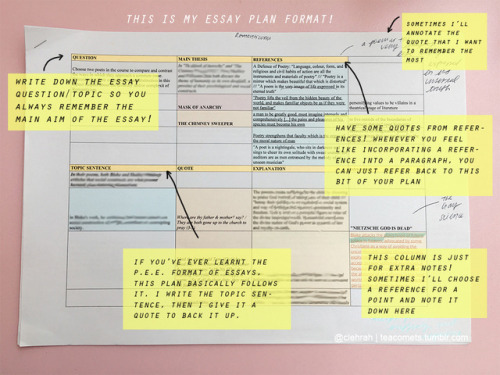
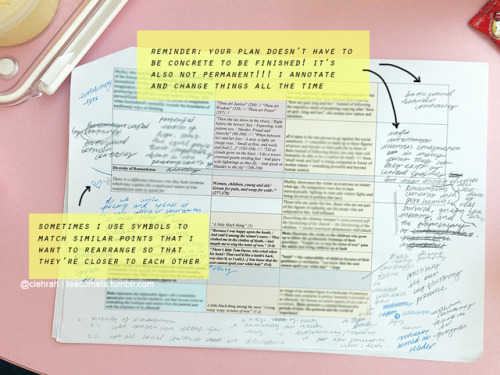
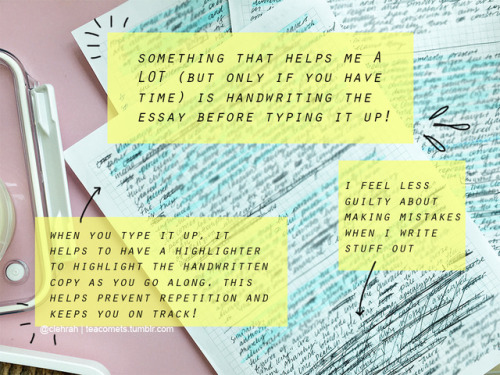
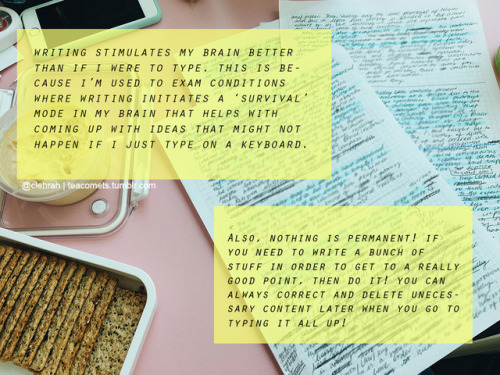

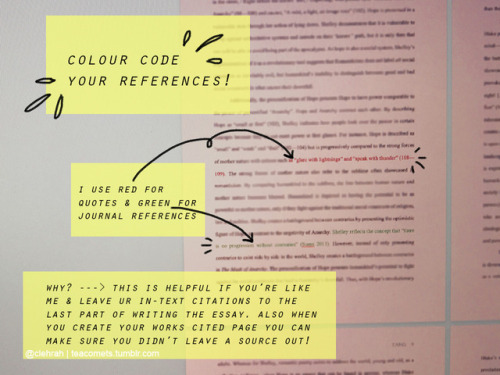
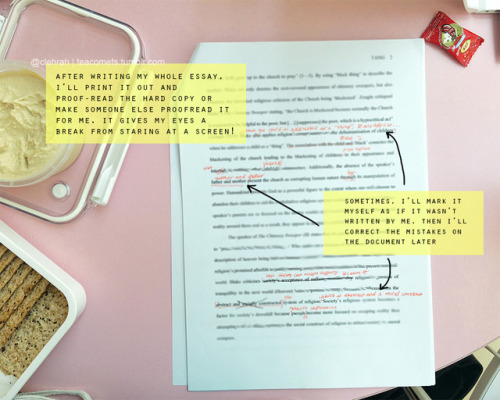

a small guide on how i battle my essays! (click on an image to view it clearer)
(keep in mind: i’m an english major so a majority of my essays are literature-focused!)
these are just some of the methods i want to share that work for me when i write my innumerable amount of essays! i’m definitely a huge planner so it’s no secret that i spend a lot of time on an essay. if you’re a deadline fighter, these tips might not necessarily be helpful (especially the handwriting one). but i hope this gives you an insight on how i write my essays! 🌈
How to Study Like a Harvard Student
Taken from Sophia Chua-Rubenfeld, daughter of the Tiger Mother
Preliminary Steps 1. Choose classes that interest you. That way studying doesn’t feel like slave labor. If you don’t want to learn, then I can’t help you. 2. Make some friends. See steps 12, 13, 23, 24. General Principles 3. Study less, but study better. 4. Avoid Autopilot Brain at all costs. 5. Vague is bad. Vague is a waste of your time. 6. Write it down. 7. Suck it up, buckle down, get it done. Plan of Attack Phase I: Class 8. Show up. Everything will make a lot more sense that way, and you will save yourself a lot of time in the long run. 9. Take notes by hand. I don’t know the science behind it, but doing anything by hand is a way of carving it into your memory. Also, if you get bored you will doodle, which is still a thousand times better than ending up on stumbleupon or something. Phase II: Study Time 10. Get out of the library. The sheer fact of being in a library doesn’t fill you with knowledge. Eight hours of Facebooking in the library is still eight hours of Facebooking. Also, people who bring food and blankets to the library and just stay there during finals week start to smell weird. Go home and bathe. You can quiz yourself while you wash your hair. 11. Do a little every day, but don’t let it be your whole day. “This afternoon, I will read a chapter of something and do half a problem set. Then, I will watch an episode of South Park and go to the gym” ALWAYS BEATS “Starting right now, I am going to read as much as I possibly can…oh wow, now it’s midnight, I’m on page five, and my room reeks of ramen and dysfunction.” 12. Give yourself incentive. There’s nothing worse than a gaping abyss of study time. If you know you’re going out in six hours, you’re more likely to get something done. 13. Allow friends to confiscate your phone when they catch you playing Angry Birds. Oh and if you think you need a break, you probably don’t. Phase III: Assignments 14. Stop highlighting. Underlining is supposed to keep you focused, but it’s actually a one-way ticket to Autopilot Brain. You zone out, look down, and suddenly you have five pages of neon green that you don’t remember reading. Write notes in the margins instead. 15. Do all your own work. You get nothing out of copying a problem set. It’s also shady. 16. Read as much as you can. No way around it. Stop trying to cheat with Sparknotes. 17. Be a smart reader, not a robot (lol). Ask yourself: What is the author trying to prove? What is the logical progression of the argument? You can usually answer these questions by reading the introduction and conclusion of every chapter. Then, pick any two examples/anecdotes and commit them to memory (write them down). They will help you reconstruct the author’s argument later on. 18. Don’t read everything, but understand everything that you read. Better to have a deep understanding of a limited amount of material, than to have a vague understanding of an entire course. Once again: Vague is bad. Vague is a waste of your time. 19. Bullet points. For essays, summarizing, everything. Phase IV: Reading Period (Review Week) 20. Once again: do not move into the library. Eat, sleep, and bathe. 21. If you don’t understand it, it will definitely be on the exam. Solution: textbooks; the internet. 22. Do all the practice problems. This one is totally tiger mom. 23. People are often contemptuous of rote learning. Newsflash: even at great intellectual bastions like Harvard, you will be required to memorize formulas, names and dates. To memorize effectively: stop reading your list over and over again. It doesn’t work. Say it out loud, write it down. Remember how you made friends? Have them quiz you, then return the favor. 24. Again with the friends: ask them to listen while you explain a difficult concept to them. This forces you to articulate your understanding. Remember, vague is bad. 25. Go for the big picture. Try to figure out where a specific concept fits into the course as a whole. This will help you tap into Big Themes – every class has Big Themes – which will streamline what you need to know. You can learn a million facts, but until you understand how they fit together, you’re missing the point. Phase V: Exam Day 26. Crush exam. Get A.
-
 kaladinstormsblessed liked this · 8 months ago
kaladinstormsblessed liked this · 8 months ago -
 nejjcollectsbooks liked this · 1 year ago
nejjcollectsbooks liked this · 1 year ago -
 moonchopsticks reblogged this · 1 year ago
moonchopsticks reblogged this · 1 year ago -
 shrimpdotpng liked this · 1 year ago
shrimpdotpng liked this · 1 year ago -
 fabfabfa-fab reblogged this · 1 year ago
fabfabfa-fab reblogged this · 1 year ago -
 verysadpostgrad reblogged this · 2 years ago
verysadpostgrad reblogged this · 2 years ago -
 jymagnie liked this · 2 years ago
jymagnie liked this · 2 years ago -
 sehungary liked this · 2 years ago
sehungary liked this · 2 years ago -
 yiddishknights liked this · 2 years ago
yiddishknights liked this · 2 years ago -
 acswinburne liked this · 2 years ago
acswinburne liked this · 2 years ago -
 marginaliamagpie reblogged this · 2 years ago
marginaliamagpie reblogged this · 2 years ago -
 marginaliamagpie liked this · 2 years ago
marginaliamagpie liked this · 2 years ago -
 ladylaurentia liked this · 2 years ago
ladylaurentia liked this · 2 years ago -
 moltes-musings reblogged this · 2 years ago
moltes-musings reblogged this · 2 years ago -
 almostreading liked this · 2 years ago
almostreading liked this · 2 years ago -
 qcio reblogged this · 2 years ago
qcio reblogged this · 2 years ago -
 bluebirdinmyheartsblog reblogged this · 2 years ago
bluebirdinmyheartsblog reblogged this · 2 years ago -
 bluebirdinmyheartsblog liked this · 2 years ago
bluebirdinmyheartsblog liked this · 2 years ago -
 strawberryinterlude liked this · 2 years ago
strawberryinterlude liked this · 2 years ago -
 heartminhc reblogged this · 2 years ago
heartminhc reblogged this · 2 years ago -
 dandyboystudies liked this · 2 years ago
dandyboystudies liked this · 2 years ago -
 criphd reblogged this · 2 years ago
criphd reblogged this · 2 years ago -
 s4m4neh liked this · 2 years ago
s4m4neh liked this · 2 years ago -
 kaladinstormsblessed reblogged this · 3 years ago
kaladinstormsblessed reblogged this · 3 years ago -
 kinkyjulieinwonderland liked this · 3 years ago
kinkyjulieinwonderland liked this · 3 years ago -
 faust-vs-mephistopheles reblogged this · 3 years ago
faust-vs-mephistopheles reblogged this · 3 years ago -
 the-shooting-star liked this · 3 years ago
the-shooting-star liked this · 3 years ago -
 sleepdeprivedpod reblogged this · 3 years ago
sleepdeprivedpod reblogged this · 3 years ago -
 pastecopy liked this · 3 years ago
pastecopy liked this · 3 years ago -
 lilypatchety liked this · 3 years ago
lilypatchety liked this · 3 years ago -
 stvdybird reblogged this · 3 years ago
stvdybird reblogged this · 3 years ago -
 ghostystudies liked this · 3 years ago
ghostystudies liked this · 3 years ago -
 starttdayynotes reblogged this · 3 years ago
starttdayynotes reblogged this · 3 years ago -
 starttdayynotes liked this · 3 years ago
starttdayynotes liked this · 3 years ago -
 lizxmartin liked this · 3 years ago
lizxmartin liked this · 3 years ago -
 sweetbisquite liked this · 3 years ago
sweetbisquite liked this · 3 years ago -
 onejnosti liked this · 3 years ago
onejnosti liked this · 3 years ago -
 voirlvmer liked this · 3 years ago
voirlvmer liked this · 3 years ago -
 pagesoflucy liked this · 3 years ago
pagesoflucy liked this · 3 years ago
a study blog for collected references, advice, and inspiration
267 posts
